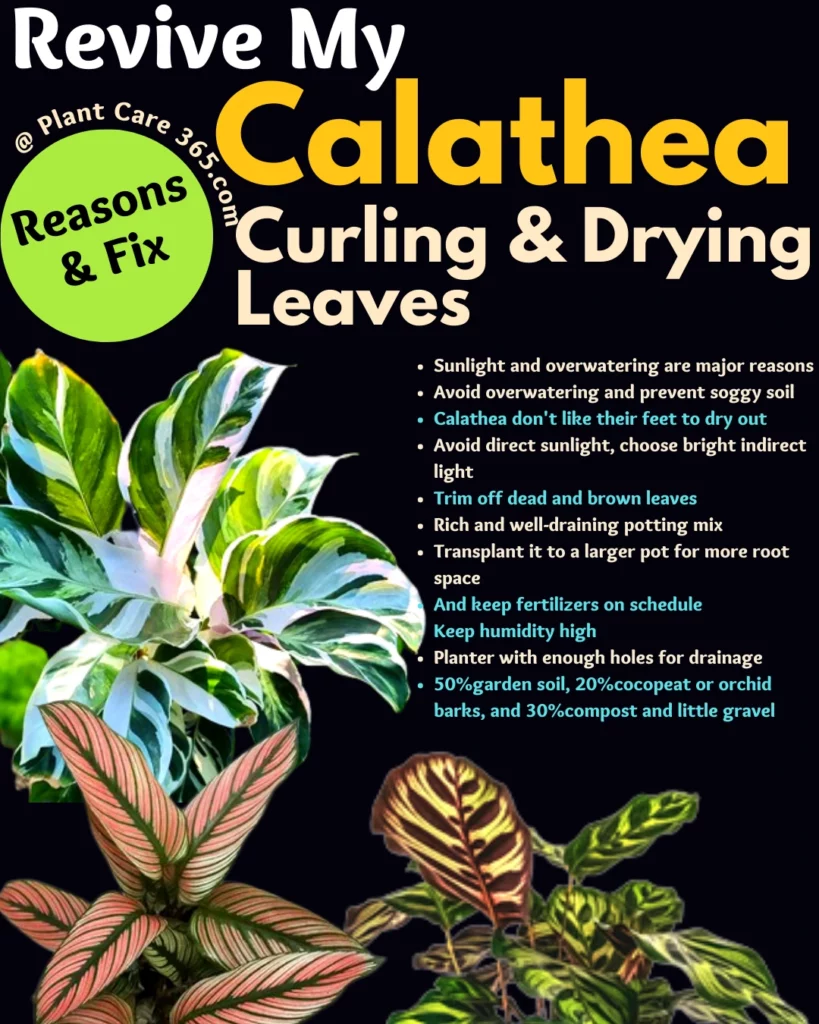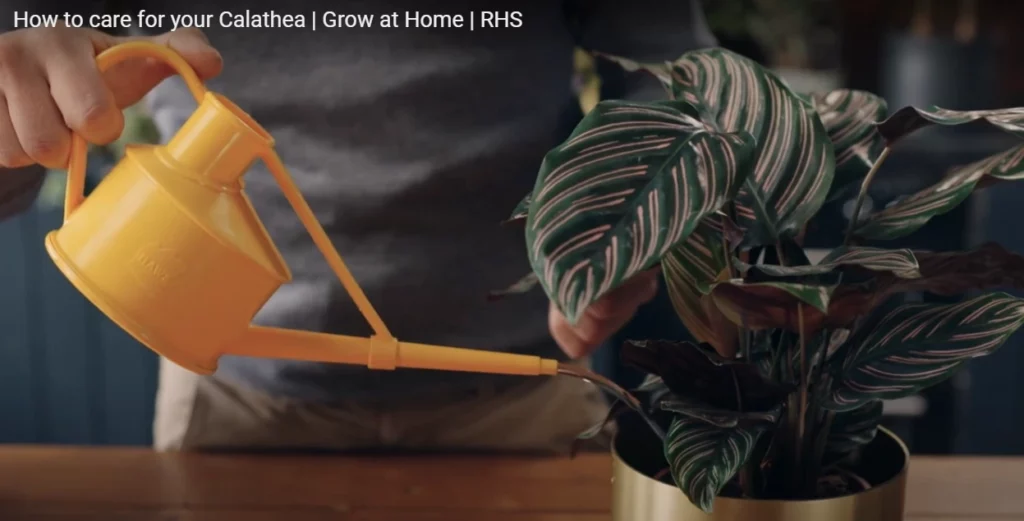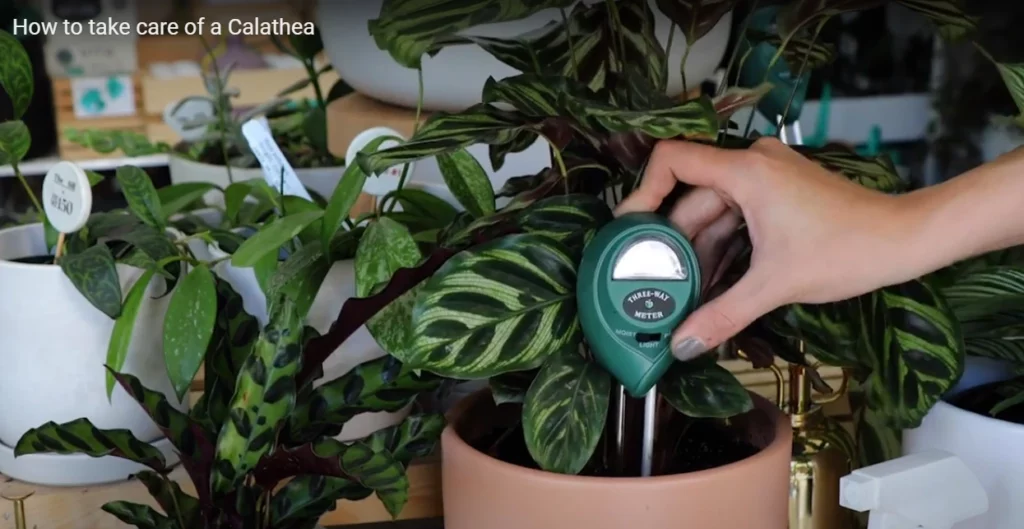Calathea is a popular houseplant that’s often used as a hanging basket or in an outdoor planter. It’s a soothing plant with bright green leaves and delicate flowers! But if it starts to die, it can be heartbreaking.
Contents: Quick Look Reasons For Curling Leaves | Causes of Curling in Detail | Save a Dying Calathea Plant | Brown Leaves on Calathea | FAQ on Calathea Care
The plant’s leaves are small, thin, and somewhat delicate, so they can get easily damaged by overwatering or too much sunlight. If your calathea has curled leaves and you’re not sure why read on!
Let’s look into a simple step-by-step guide on how to save your dying calathea from slow death:
Long story short: Save Calathea Curling & Drying Leaves
- Too much sunlight and over/less watering are the major reasons for curling and crispy leaves
- Avoid overwatering and prevent soggy soil
- And yes they also don’t like their feet to dry out
- Avoid direct sunlight, place it in a spot with enough indirect bright light
- Don’t be afraid to trim off dead and brown leaves
- Yes entirely brown crispy leaves won’t come back to life
- Choose a potting mix that is rich and well-draining
- If it is outgrown for that pot, transplant it to a larger pot for more root space
- And keep fertilizers on schedule (prevents overfeeding and underfeeding)
- Keep humidity high for this tropical plant
- Planter with enough holes for drainage and a well-draining potting mix
- Potting mix with 50%garden soil, 20%cocopeat or orchid barks, and 30%compost and little gravel

Why are my Calathea leaves curling and crispy?
If you are seeing the leaves of your Calathea plant curling, it is likely because of sunlight issues and the watering schedule.
- The best way to make sure that your Calathea receives enough sunlight is by placing the pot in an area where there is not too much sunlight.
- And where it will not get too hot during the summer months (this means that if your house has air conditioning or heating systems, this might not be ideal).
- Also, make sure that they do not get any direct sunlight while they are indoors because this can cause burns on their leaves as well as scorch them off completely!
Related: Calathea orbifolia brown edges and propagation
What does an overwatered Calathea look like?
If you have a watering problem, your Calathea leaves may look like this:
- Yellow and wilted
- Droopy and wilted
- Wet soil surrounding the plant that’s been sitting in a saucer of water for days or weeks.
- The plant could also be droopy because it lacks nutrients (absorption).
Related: How to save an overwatered rubber plant
Video
Reasons for curling leaves in calathea
- Lack of moisture
- Overwatering
- Too much sunlight
- Wrong potting mix
- Climate and Humidity
- Cold shock
If you have a dying calathea plant and it has curled leaves, there are several things that can cause this.
The most common reason for this is lack of moisture. If your plant is too dry or getting too much water at once, the leaves will wilt and curl up as they dry out.
Also, if you have placed your calathea in an area where there is no sun exposure or where it gets direct sunlight all day long (such as a window sill), then you’ll notice that its leaves start turning brown or dying altogether!
7. Overwatering
The most common cause of curling leaves on your calathea plant is over-watering. This can happen when you don’t water enough or allow the soil to dry out completely between waterings. Overwatering can also lead to root rot, which causes the roots to rot and die off.
To prevent this problem from happening again, make sure you’re using a long-lasting organic fertilizer every time you water your plants—and don’t forget about their soil!
If you do overwater your plant, the leaves will start to curl up and turn brown. When this happens, it’s best to remove the soil from around the roots so you can inspect them for signs of rot.
If you don’t see any obvious signs of infection in the roots (such as white or black mold), then simply allow your calathea plant to dry out completely before watering again.
Related: How to save an overwatered peace lily plant
1. Wrong potting mix and soil
It’s essential to use the right mix for your Calathea plant. The potting mix should be light and aerated, as well as high in moisture-holding capacity.
- If you don’t have organic potting soil on hand, try using sand instead of perlite or vermiculite. As it will retain more moisture than other types of soils do.
- The answer to your question may be as simple as water. If you are overwatering, you will have problems with curling leaves and brown tips in your Calathea plant.
- Another reason for your calathea leaves to curl is that they are getting too little sunlight or too much sunlight. A third cause of the problem is a nutrient deficiency (i.e., not enough nitrogen).
- Finally, if your potting mix is wrong for growing this type of plant then it can damage the roots which causes them to die off!
Related: Why my aglaonema plant leaves are curling
2. Nutrient Deficiency
Calathea plants are very sensitive to nutrient deficiencies and can be caused by overfeeding or underfeeding. If you notice that your plant leaves are curling up and turning yellow, it may be suffering from a nutrient deficiency.
To treat this problem, simply repot the plant into a larger container with more soil until the roots have filled out again and the leaves grow back to normal size.
3. Too Much Sunlight
Calathea is a tropical plant, and it should be placed in a shady area. If you’re trying to revive your dried-out leaves, place the pot of calathea on its side where the soil level is about 1 inch deep. This will help prevent water from evaporating too quickly.
It’s also important to make sure that your plant receives enough light throughout the day; if its environment is too dark or dimly lit then it may not grow well or flower as expected.
Calathea plants will burn if they get too much direct sunlight. This can happen in two ways:
- The leaves will turn yellow and drop off of the plant, or
- The leaves will become singed and curled, leaving a droopy appearance on the plant’s stems.
Related: Reasons why my Syngonium leaves are curling
4. Too much/less moisture
Too much moisture. Watering too often can cause roots to rot and plants to die, especially when you’re in a hurry to get a project done.
- If you want your Calathea plant leaves to be curling back on themselves because of too much water, try setting aside an hour or two after watering before moving forward with other tasks so your plants have time to absorb all that moisture without drowning in it!
- In case of root rot, roots will recover soon enough once the soil dries out again; give the soil good drainage by placing it on top of pebbles or gravel instead of directly on the ground (this will also help prevent fungal diseases from spreading).
Too little water: If you have an overspill problem with your pots of soil (or if they seem too dry), adding more water is one way around this issue—but make sure not just any kind will do!
- You should use distilled or filtered tap water instead; otherwise, it could affect how well they grow as well as what type of fertilizer would work best for them based on their needs at this particular moment in time.
5. Climate & Humidity
Calathea plants are hardy. They can withstand various conditions, including low light and dry air. But they do have some specific requirements that you need to follow in order for them to thrive:
- Humidity is important. Calathea needs to be kept moist, which means you should use a humidifier or place the plant on a tray of pebbles and water.
- Direct sunlight is not good for this plant; the leaves will burn if they are exposed to direct sunlight for too long.
- Indirect light is best for calathea since it’s native to tropical regions with lots of rainfall and humidity levels that allow these plants to thrive in their natural habitat (which may mean they’re not as happy indoors).
- Keep humidity levels high during the growing season so that leaves don’t get scorched by sudden changes in temperature during summer months when temperatures rise quickly after sunset; this applies particularly if you live near an ocean beach where temperatures aren’t as extreme year round!
Related: Reasons and Fix for fern leaves curling
6. Cold Shock
If you have cold shock, there are a couple of things you can do. First, keep your plant away from direct sunlight until it recovers. Second, water your Calathea plant with warm water instead of cold.
Thirdly and finally, if you see that one leaf has curled up and another is drooping down—remove both leaves from the pot and replant them somewhere else (this will help prevent further damage).
If you are about to transplant
Cut off all damaged areas on the rootstock using sharp pruners or secateurs; use these tools to remove as much dead wood as possible without damaging any new growth underneath.
Related: Reasons why my Rosemary is dying
How to Revive My Dying Calathea?
Many houseplants die or fail to thrive once their leaves have dropped, but prayer plants are an exception—regardless of how they’ve been treated in the past.
- Bring it inside if you can. If the plant is outdoors, bring it into the house and place it in an area with indirect sunlight and moderate temperatures (around 60 to 70 degrees Fahrenheit).
- Don’t overwater. It is best not to keep your calathea in direct sunlight, which might be overheated and cause its leaves to wilt or die back completely.
- Also, avoid fertilizing your plant too often because this can stress out its roots and make them weak so that they are unable to support themselves anymore.
- Also, instead of watering just once per week or two weeks at most, try using drip irrigation along with a soaker hose so that you don’t have to worry about over-watering but still ensure adequate moisture levels throughout all seasons of growth!
If things don’t work repot your plant
- Remove the plant from its pot.
- Remove the soil, soak it in a bucket of water, and allow it to dry out completely.
- Replant in a new pot with fresh soil (your old pot will have to go) and water sparingly until new growth appears.
How often to water curling calathea?
If your Calathea plant is curling its leaves, it means that there’s not enough water in the soil.
Calathea is a tropical plant and needs moist soil to thrive. Watering once a week is enough for this type of plant, but if you are not sure if it needs water, test the soil with your finger: if it has cracks or feels dry, then pour some water into them.
Related: Save a dying basil plant
My Calathea has brown leaf tips, should I trim them?
You can use a soft brush to remove dust and dirt from the leaves. If you find that your calathea leaves are turning brown at their tips, don’t be afraid!
- If the leaves of your Calathea appear lifeless or dead, prune them at their base.
- It’s normal for them to do this when they are dying up. This is a sign that you need to trim the brown spots off of your plant so that it will grow back healthy again.
- If you decide that you want to trim away any dead or damaged parts of your plant (leaves), then go ahead and do it!
- Just make sure that whatever kind of cutting tool is used on the stem is sterilized beforehand by wiping it down with rubbing alcohol before using it on your plant.
- Also note that Calathea’s leaves can droop if the plant is exposed to a sudden change in temperature, lacks sufficient humidity, or becomes infested with pests.
FAQ on Curling Leaves
Q1: What are the most common reasons for curling leaves in calathea?
A1: The most common reasons for curling leaves in calathea are lack of moisture, overwatering, too much sunlight, wrong potting mix, climate and humidity, cold shock, and nutrient deficiency.
Q2: What should I do if my calathea leaves are curling?
A2: If your calathea leaves are curling, check the amount of moisture in the soil, make sure the plant is not getting too much or too little sunlight, make sure the potting mix is correct for the plant, and increase humidity levels.
Q3: What should I do if my calathea is overwatered?
A3: If your calathea is overwatered, allow the soil to dry out completely before you water again. If you see signs of root rot, inspect the roots for any signs of infection, such as white or black mold, and remove the soil from around the roots.
Q: How do I avoid overwatering my Calathea?
A: To avoid overwatering your Calathea plant, make sure to water it only when the soil is dry and to use distilled or filtered tap water. You can also place the pot on top of a tray of pebbles and water to increase humidity around the plant.
Q: How can I keep my Calathea plant healthy?
A: To keep your Calathea plant healthy, make sure to place it in an area with indirect light and high humidity. You should also use a potting mix that is rich and well-draining, fertilize it on schedule, and water it only when the soil is dry. Additionally, you should trim off dead or brown leaves and transplant it to a larger pot if it is outgrowing its current one.
Reference:









